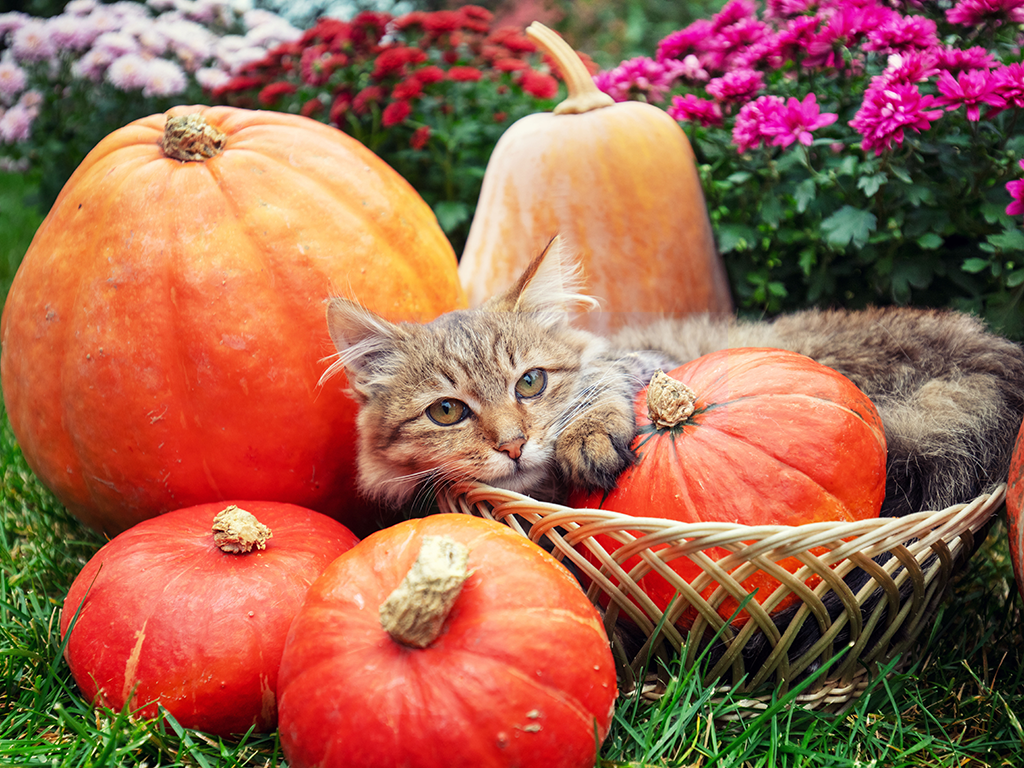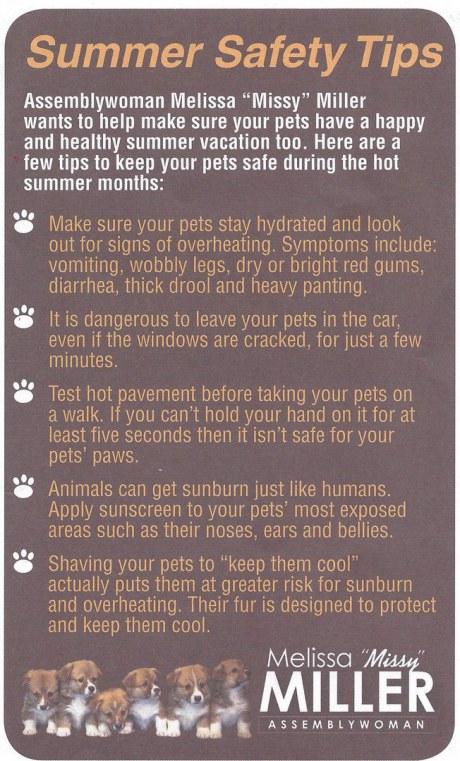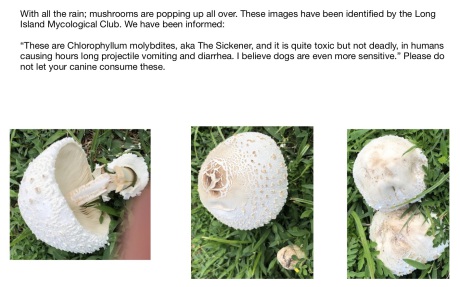Warm weather pet safety
You might know that cold weather poses health risks to your pets, but so does warm weather – even on days that don’t seem that hot to you. Knowing the risks and being prepared can help keep your pet safe.
Be prepared
-
Talk to your veterinarian about warm weather risks for pets (and travel safety if you plan to travel with a pet).
-
Make sure your pets have unlimited access to fresh water, and access to shade when outside.
-
Keep your pet free of parasites that are more common during warm weather, such as fleas, ticks and heartworm.
-
Ask your veterinarian how to recognize signs of heat stress.
Keep pets at home
-
Leave your pets at home if possible when you need to go out and about.
-
Provide different temperature zones within your house for your pet’s comfort.
-
Never leave a pet in the car, even in the shade or with windows cracked. Cars can overheat quickly to deadly temperatures, even when the weather isn’t severe.
Keep them comfortable
-
If it’s hot outside for you, it’s even hotter for your pet.
-
Take walks, hikes or runs during the cooler hours of the day.
-
Avoid hot surfaces, such as asphalt, that can burn your pet’s paws.
-
Ask your veterinarian if your pet would benefit from a warm-weather haircut or sunscreen.
Exercising with your pet
-
Consult your veterinarian prior to starting an exercise program for your pet. Overweight pets and short-nosed dog breeds have higher risk of problems with warm-weather exercise.
-
Don’t walk, run or hike with a dog during the hottest parts of the day or on particularly warm days.
-
Take frequent breaks.
-
Bring enough water for both you and your pet.
Garden and yard safety
-
Make sure the plants in your garden and yard are safe for pets.
-
Store lawn fertilizer and insecticides out of reach of your pets.
-
Always follow safety instructions on lawn and garden products, particularly the instructions on how long you should keep pets out of the treated areas.
-
If you use a lawn service, make sure they are aware that you have pets.
-
Avoid using cocoa bean mulch, which contains the same pet toxin found in chocolate.
7 Foods to Avoid Feeding Your Dog or Cat
If any of these are consumed; call your veterinarian as soon as you know it has happened.

- Xylitol-containing products (xylitol is an artificial sweetener often found in sugar-free candy and gum and other foods to decrease the sugar intake);
- Chocolate (although some types of chocolate are not as toxic as others, it's safer to keep your pet away from all types of chocolate);
- Onions;
- Grapes and raisins;
- Fatty and fried foods;
- Macadamia nuts
- Avocados
Updated Article on Halloween Safety

When the leaves begin to turn colors and pumpkins appear on neighborhood porches, you know that Halloween is just around the corner. While spooky season is a fun time of the year for many people, it can also become a little too scary for pets if owners don’t take precautions.
Dr. Erin Ray, a clinical assistant professor at the Texas A&M College of Veterinary Medicine & Biomedical Sciences (VMBS), and Dr. Lori Teller, a VMBS clinical professor, share their veterinary advice for keeping pets safe at Halloween to help pet owners best celebrate the spooky season with their furry friends.
Halloween Food Safety For Pets
One of the most iconic parts of Halloween is the food, including candy and party snacks like popcorn balls and caramel-covered apples. Because these foods are abundant at this time of year, pet owners should pay close attention to what treats their animals indulge in.
“It is vital to be careful with any candy and food that could be potentially toxic for your pet to ingest throughout this holiday season,” Ray said.
Common ingredients that are harmful for pets include:
- Chocolate
- Onion
- Garlic
- Xylitol (an artificial sweetener)
- Any fatty or rich food
“Pet treats are a fun thing to give to pets, as long as they aren’t too rich, don’t contain toxic ingredients, can’t pose a choking hazard, or aren’t too hard,” Ray said.
If you find yourself in a situation where your pet has consumed something potentially detrimental to their health, The ASPCA’s Animal Poison Control can be reached at (888) 426-4435 and the Pet Poison Helpline can be reached at (855) 764-7661.
Alternatives To Offering Treats
If you’re concerned about the contents of pet treats, another way to celebrate Halloween while keeping your pet safe is by investing in a new toy.
“Toys that can’t be ripped apart, broken into pieces, or have pieces taken off of them are a great thing to give your furry friend during the holidays, with owner supervision,” Ray said. “This is particularly true for string toys for cats.”
Helping Pets Cope With Crowds And Noises
Visiting haunted houses and watching horror movies may be how some Halloween enthusiasts enjoy celebrating the season, but pets don’t always share their owners’ affinity for the frightening.
“Pets can exhibit signs of fear in new, crowded, or loud situations, which would include places like haunted houses, hay mazes, and even loud movies in their normal home,” Ray said. “They can often mirror their owner’s emotions, too, so if an owner is scared, nervous, or anxious, the pet can show similar signs.”
Ways that pets exhibit fear and anxiety can include:
- Ears back and tail tucked
- Dilated pupils
- Hiding/cowering
- Trying to run away
- Hair on back/tail erect
Dogs may also show fear by barking or biting, while cats may hiss or swat.
Is Trick-Or-Treating Safe For Pets?
Whether your pet should accompany you out for a night of trick-or-treating is largely dependent on their personality and how familiar they are with the activity. Even if you intend to stay at home for the night, Ray encourages owners to make sure to consider your pet’s comfort when making your Halloween plans.
“Parties and trick-or-treating can be fun for some animals, such as well-socialized dogs or cats who enjoy the attention, but these activities can be stressful for others because of the scary shapes and sounds, like the doorbell ringing,” Ray said. “Costumes can also scare pets if they are big, elaborate, or not something that the animal has seen before.”
With this in mind, Ray strongly recommends that pet owners take caution during parties where a pet could come across unsuspecting threats. If people are visiting, it’s also important to communicate which treats can and cannot be shared with pets.
“A trial run with a small group of friends can be a good way to assess how your pet will respond to other people, and start getting them familiar with parties and festivities,” Ray said.
Dealing With Halloween Decorations
Just as some people prefer to celebrate the season with harvest imagery and others lean into the spooky side, pets’ love of Halloween decorations can be personality-dependent.
“Many animals do not appreciate large, new decorations that could scare them or make them nervous, while others may enjoy playing with them or trying to chew them,” Ray said. “Any decorative items lying around that could be chewed on or swallowed have the opportunity to become foreign body risks.”
Are Pumpkins Safe For Pets?
In general, pumpkin can be an excellent treat for cats and dogs because it is both tasty and low in calories, making it a healthy alternative to traditional treats.
“Pumpkins are roughly 90% water, so they can be filling for a pet without increasing their caloric intake, which is beneficial for overweight or obese pets,” Teller said.
Letting pets munch on the insides of a fresh pumpkin, can provide other health benefits, specifically by providing fiber that can ease digestive issues, but only if eaten in conservative amounts.
“Because the seeds or the fibrous strands are very high in fiber, eating too much can cause stomach upset,” Teller said. “When owners let their pet eat pumpkin, they should think of it like they are feeding their pet treats — treats should make up less than 10% of their total caloric intake.”
Halloween is a time for candy, laughs, and a scare or two. With some simple adjustments, it can be a fun holiday for the entire family.
Leptospirosis "Lepto" is a disease caused by infection with Leptospira bacteria. Some of the ways your pet can get "Lepto" is by eating grass where infected animals have been. Ask the doctor how you can safegard your pet today.
Don't forget to have your dog tested for heartworm diease. Heartworms are transmitted by the bite of a mosquito. The larva primarily reside and cause damage to the blood vessels of the lungs. Remember to call for an appointment and don't forget tto ask about fleas and ticks.
Outdoor cats are exposed to a variety of viruses (especially rabies) and therefore need to be protected against these dieases.
In puppies and kittens parasites rob your pet of healthy development and in some cases are transmitted to humans. Bring a stool sample at your next visit.
I have noticed a rise in Leptospirosis. Call me to discuss if your pet should be vaccinated against this bacteria.
Call for an appointment today.
<< 7 Things to keep your pet safe for Halloween>>
7 Things You Can Do to Make Halloween Safer for Your Pet
- Don't feed your pets Halloween candy, especially if it contains chocolate or xylitol (a common sugar substitute found in sugar-free candies and gum);
- Make sure your pet is properly identified (microchip, collar and ID tag) in case s/he escapes through the open door while you're distracted with trick-or-treaters;
- Keep lit candles and jack-o-lanterns out of reach of pets;
- If you plan to put a costume on your pet, make sure it fits properly and is comfortable, doesn't have any pieces that can easily be chewed off, and doesn't interfere with your pet's sight, hearing, breathing, opening its mouth, or moving. Take time to get your pet accustomed to the costume before Halloween, and never leave your pet unsupervised while he/she is wearing a costume;
- Keep glow sticks and glow jewelry away from your pets. Although the liquid in these products isn't likely toxic, it tastes really bad and makes pets salivate excessively and act strangely;
- If your pet is wary of strangers, or has a tendency to bite, put him/her in another room during trick-or-treating hours or provide him/her with a safe hiding place;
- Keep your pet inside.
Wtih the rain; mushrooms are everywhere!
Contact
Home Veterinary Services, LLC
Hal Waldman
Long Beach, NY 11561
Phone
516 432-9258
Pet Poison Helpline:
952-806-3803
Payment Types: Check, Credit Cards and Cash
Office Hours
By Appointment only
News
Winter holiday pet safety
https://www.avma.org/resources-tools/pet-owners/petcare/holiday-pet-safety
SIGNS OF HEAT STRESS
Seek emergency veterinary care if you observe any of these signs:
- Anxiousness
- Excessive panting
- Restlessness
- Excessive drooling
- Unsteadiness
- Abnormal gum and tongue color
- Collapse
=============================7 foods to avoid feeding your pet
Check out news tab about Halloween and pet safety
With the rain; mushrooms are everywhere!
See News tab in upper menu bar
Fido & Felix disasters for the holidays
Alcohol Amaryllis Chocolate Garlic Holly Lily Mistletoe Onion Poinsettia Xylitol
Heartworm testing season for dogs
Ask me about appropriate vaccines for cats
Parasite checking for puppies and kittens
Is Pet Insurance Worth the Cost? http://www.consumerreports.org/pet-products/is-pet-insurance-worth-cost/
Check out Dog TV in Archives or http://dogtv.com/





